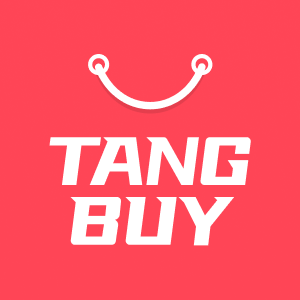How to Price Dropshipping Products to Boost Sales and Margins in 2025
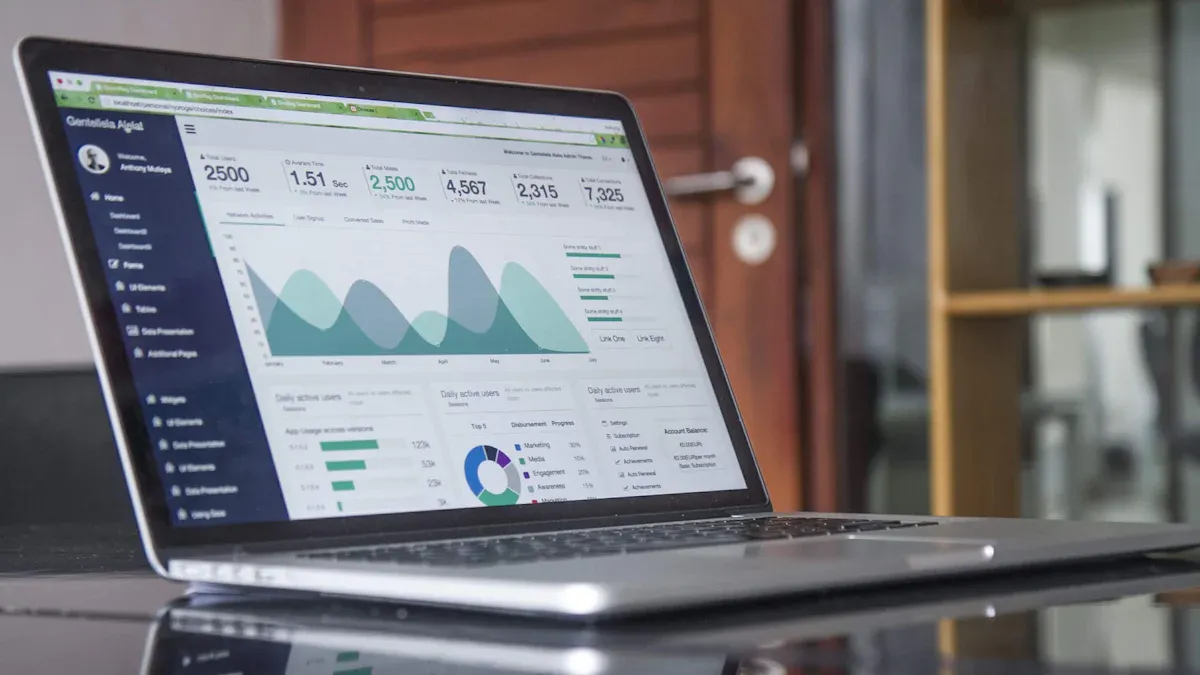
If you want to price dropshipping products well in 2025, you must find a good balance. This balance is where profit and being competitive meet. Most dropshippers get profit margins from 10% to 30%. Getting higher margins needs more than just looking at numbers. You will face real problems like supplier delays and long shipping times. There is also a risk of losing profit if you only compete on price. You should stay flexible and focus on value to keep your advantage.
Key Takeaways

Set prices that help you make money and stay competitive. This will bring in customers and keep your profits strong.
Try different pricing strategies like cost-plus, competitive, value-based, and dynamic pricing. Choose the best one for your products and market.
Work out all your costs, including shipping and fees. This helps you not lose money when you make a sale.
Check what your competitors charge often. Change your prices to keep up, but do not start price wars.
Use psychological pricing tricks like charm pricing and urgency. These can help you sell more and build trust with customers.
Use automation tools to change prices fast. This saves time and keeps your profits safe.
Get people to spend more by offering bundles, cross-sells, and free shipping if they buy enough.
Test your prices often. Listen to what customers say. Change your plan to stay ahead in the fast-moving dropshipping market.
Why Pricing Matters

Sales Impact
When you set your prices, you shape how customers see your shop. If you price dropshipping products too high, people may leave your site without buying. If you go too low, you might get more sales, but you could lose money on each order. You want to find that sweet spot where your price feels fair and attractive. Using tricks like pricing at £9.99 instead of £10 can make your products look like a better deal. Bundling items together at a small discount can also encourage shoppers to buy more. You can even adjust your prices based on what your competitors do or how customers behave. This keeps your shop fresh and helps you stay ahead. When you test different prices and watch what works, you can boost your sales volume and keep your profits healthy.
Tip: Always show clear shipping and handling costs. This builds trust and helps customers decide to buy.
Margin Impact

Your profit margin is what you keep after paying for the product, shipping, and other costs. Most dropshippers see margins between 10% and 30%. If you want to reach higher margins, like 50% or more, you need to be smart with your pricing. Start by covering all your costs, then add a markup that makes sense for your market. If you notice your products selling well, try raising your prices by a small amount. Even a £1 increase can make a big difference if your sales stay strong. On the other hand, if sales slow down, lowering your price might help. You can also use bundle deals or upsells to increase the average order value. This way, you earn more from each customer without needing to find new ones. Remember, the way you price dropshipping products has a direct effect on your bottom line.
Pricing Method | How It Works | Margin Impact |
|---|---|---|
Add a set markup to your costs | Keeps margins steady | |
Value-Based | Price based on customer value | Can boost margins for unique items |
Bundle Pricing | Sell sets at a discount | Raises average order value |
Charm Pricing | Use prices like £9.99 | Increases sales, helps profits |

2025 Competition
The dropshipping world will get even tougher in 2025. More people will open shops, and new platforms will pop up. You will need to keep up with changes and find ways to stand out. Shops that focus on a special niche or offer something new will do better. Using the latest tech, like AI or automation, can help you set smart prices and save time. You also need to follow new rules about data and taxes. If you want to grow, look at markets in places like Southeast Asia or Africa. These areas are growing fast and offer lots of chances. To win in 2025, you must stay flexible, keep learning, and always look for ways to improve your pricing and service.
Price Dropshipping Products: Strategies

Cost-Plus
Cost-plus pricing is one of the easiest ways to price dropshipping products. You start by adding up all your costs. This includes what you pay your supplier, shipping, and any fees. Then, you add a set amount or percentage on top. For example, if your supplier charges £10 and you want a 30% profit, you set your price at £13. Some dropshippers use the 3x rule, where you multiply the supplier price by three or three and a half. This helps cover your costs and leaves room for profit.
Pros:
Simple to use and quick to calculate.
You always know your profit margin.
Easy to adjust if your costs change.
Cons:
Ignores what customers think your product is worth.
May not match what your competitors charge.
Sometimes does not cover all your business costs.
Can lead to prices that look odd or are not competitive.
Tip: Cost-plus works best for evergreen products and items with steady demand. It is less effective in crowded markets where many shops sell the same thing.
Competitive
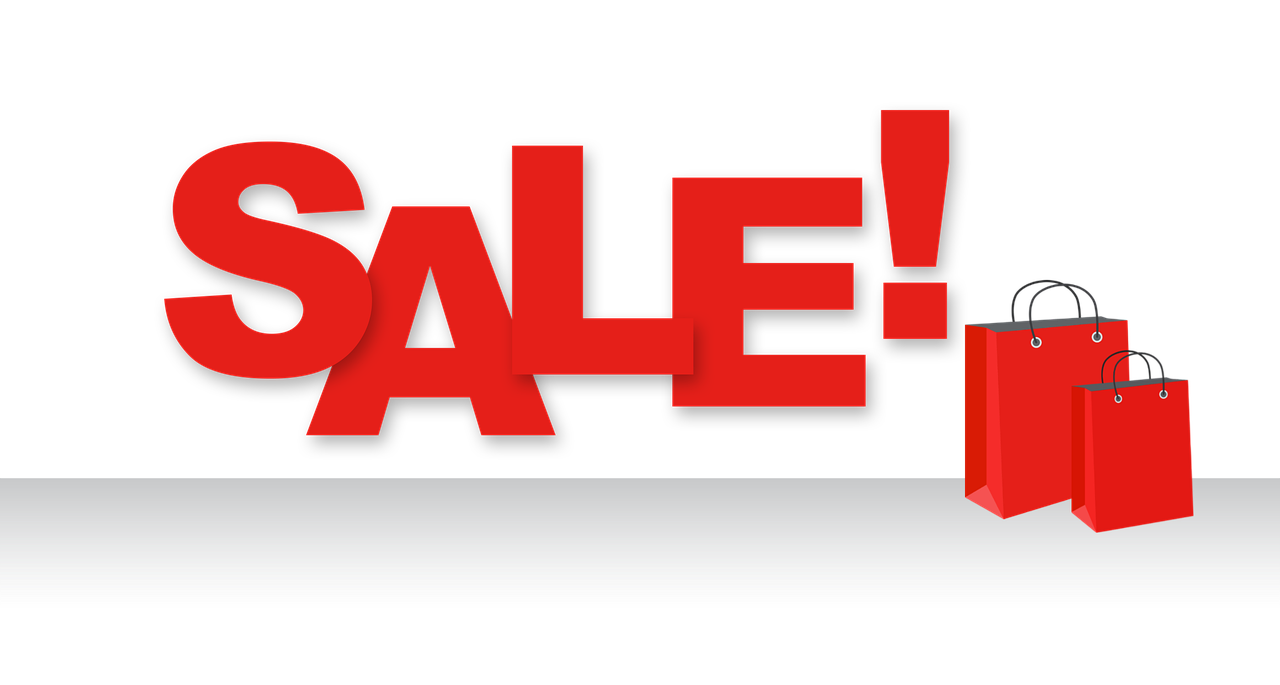
Competitive pricing means you look at what other shops charge for the same or similar products. You then set your price to match, beat, or stay close to theirs. This strategy helps you enter the market quickly and attract customers who compare prices. If you sell popular gadgets or trending items, you will find this method useful. You can also use tools to track competitor prices and adjust yours automatically.
Why use competitive pricing?
Helps you win customers in busy markets.
Makes your shop look fair and trustworthy.
Lets you react fast to changes in the market.
Watch out for:
If you only copy others, you might miss out on extra profit.
You could start a price war, which hurts everyone’s margins.
You still need to cover your own costs and make sure you do not lose money.
Competitive pricing works best when you sell products that many other shops offer. If you sell unique or niche items, you might want to try a different approach.
Value-Based
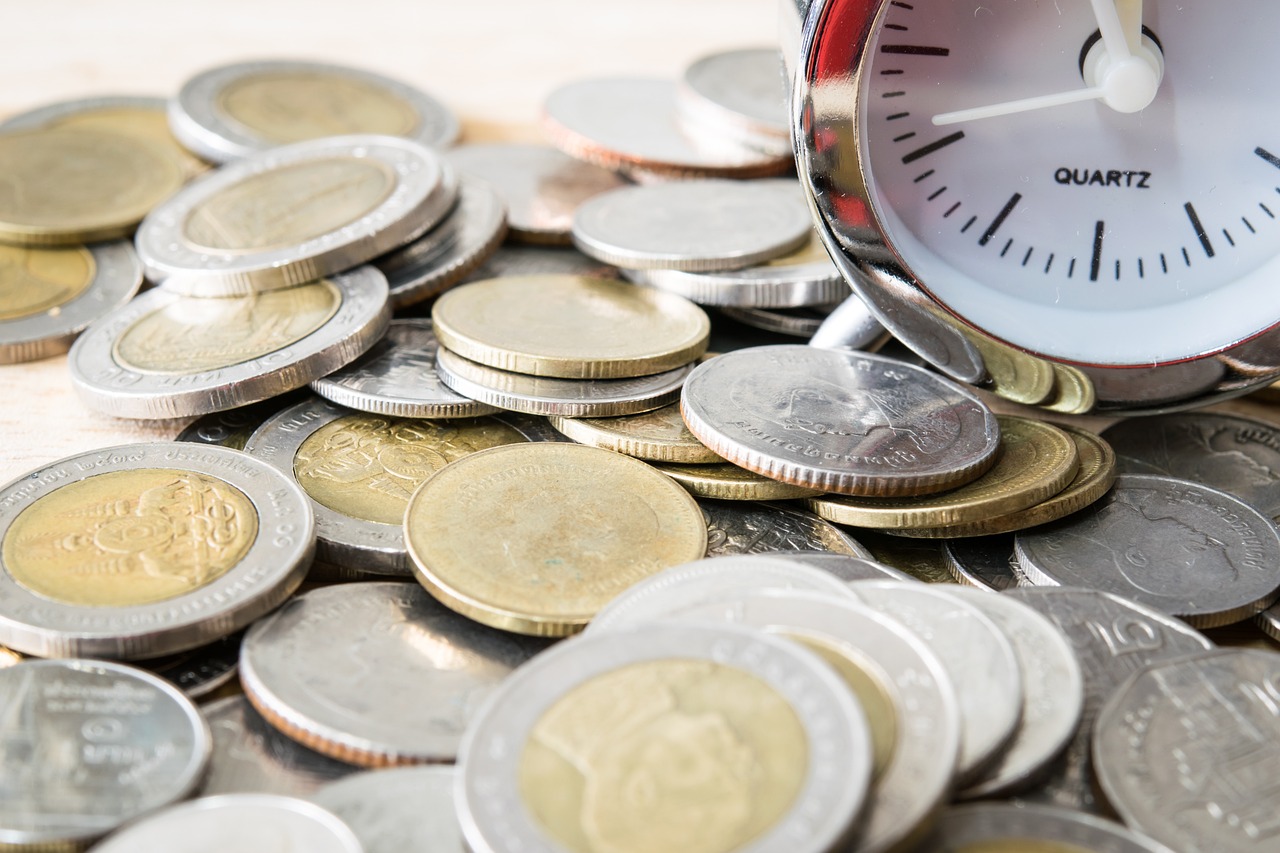
Value-based pricing is all about what your customer thinks your product is worth. You set your price based on the value you deliver, not just your costs. If your product solves a big problem, looks special, or has features others do not, you can charge more. This strategy works well for high-ticket items, unique gadgets, or products in a special niche.
Benefits:
Lets you earn higher profit margins.
Helps your products stand out as premium or exclusive.
Builds customer loyalty because people feel they get something special.
Drawbacks:
Harder to figure out the right price. You need to know what your customers value.
If you do not explain the value, customers may not want to pay more.
Not the best choice for basic or common products.
Note: To use value-based pricing well, talk to your customers and learn what matters to them. Show them why your product is worth the price.
Here’s a quick table to help you choose the right strategy:
Strategy | Best For | Main Focus |
|---|---|---|
Cost-Plus | Evergreen, steady items | Covering costs |
Competitive | Popular, common goods | Beating rivals |
Value-Based | Unique, high-ticket | Customer’s view |
When you price dropshipping products, you can mix these strategies or switch between them as your shop grows.
Dynamic

Dynamic pricing lets you change your prices in real time. You set rules, and smart tools do the rest. These tools watch your product’s performance, like how many people view, add to cart, or buy. If a product starts selling fast, the tool can raise the price to boost your profit. If sales slow down, it can drop the price to attract more buyers. You do not need to watch your shop all day. The system works for you, even while you sleep.
Automation tools make dynamic pricing easy. They track your inventory and update prices when your supplier changes costs. Some tools, like AutoDS, act like a pricing ninja. They tweak your prices up or down based on real-time demand. You set your rules once, and the tool keeps your shop competitive and profitable. AI-powered tools can even check what your rivals are doing and suggest new prices or special offers. This saves you time and helps you stay ahead in a busy market.
Pros:
Saves you hours by automating price changes.
Keeps your prices competitive at all times.
Helps you react fast to trends and demand spikes.
Cons:
Needs good setup and clear rules.
Can confuse customers if prices change too often.
Some tools cost money to use.
Dynamic pricing works best for trending products, seasonal items, or anything with fast-changing demand. If you want to price dropshipping products for maximum profit and flexibility, dynamic pricing is a smart choice.
Psychological

Psychological pricing uses tricks to make your prices look better to shoppers. You can use many simple tactics to boost sales and make your shop stand out.
Charm pricing: Set prices like £9.99 instead of £10. Shoppers see £9.99 as much cheaper, even though it is only one penny less.
Smaller font sizes and no commas: Prices look lower and less scary.
Prestige pricing: Set higher prices to show your product is top quality. People trust expensive items more.
Urgency and scarcity: Show “Only 2 left!” or use countdown timers. This makes people buy quickly because they fear missing out.
Price comparison: Show the old price or a higher competitor price next to your price. Your offer looks like a bargain.
Social proof: Add reviews, ratings, and testimonials. Shoppers trust your shop more and feel safe paying a bit extra.
Free shipping thresholds: Offer free shipping if customers spend over a certain amount. This makes them add more to their basket.
Bundle pricing: Sell sets of products at a small discount. This increases the average order size.
Decoy pricing: Add a less attractive option to make your main product look like a better deal.
Currency symbols: Leaving out the £ sign can make prices feel smaller, but adding it can build trust.
Tip: Mix two or three of these tactics for the best results. For example, use charm pricing with a countdown timer and show reviews under your product.
Psychological pricing works for almost any product. It is especially powerful for gadgets, gifts, and impulse buys. When you price dropshipping products, these small changes can make a big difference in your sales.
Set Prices Step by Step
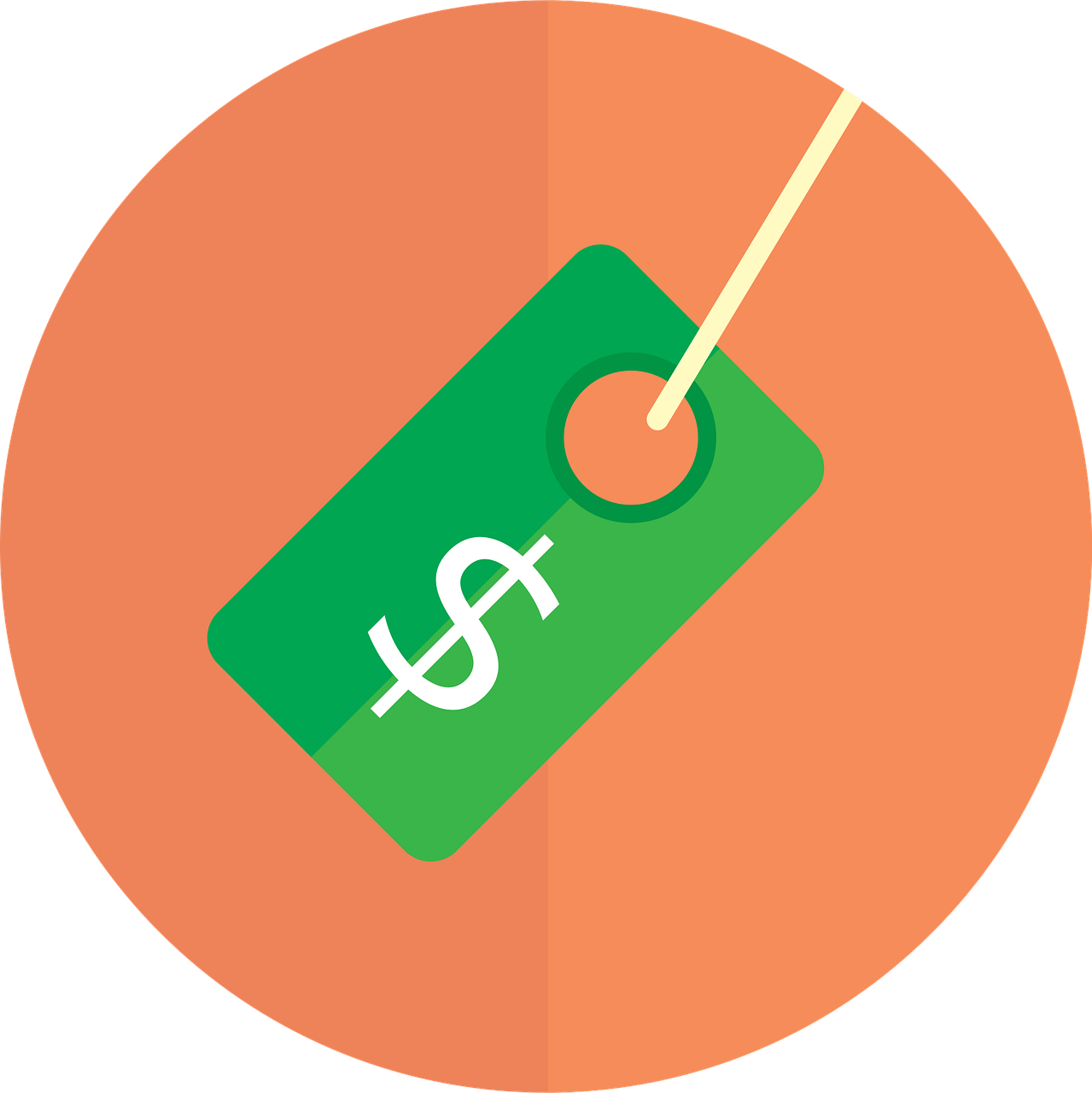
Calculate Costs
Getting your pricing right starts with knowing your true costs. If you skip this step, you might set prices that look good but leave you with little or no profit. Here’s a simple way to work out your all-in costs for each product:
List every variable cost for each item. This includes what you pay your supplier, shipping, packaging, payment provider fees, advertising, and even taxes or customs duties.
Add up your fixed costs. Think about things like your website subscription, licences, insurance, or any software you use. Work out how much of these costs should go to each product based on your expected sales.
Use a breakeven calculator to see how your fixed and variable costs affect your pricing. This helps you spot the minimum price you need to cover everything.
Decide on your profit margin. Many dropshippers aim for 20% to 30%, but you can go higher if your product is unique or in demand.
Double-check your numbers with a pricing template or shipping calculator. This makes sure you haven’t missed anything.
Tip: Always include every fee, even the small ones. If you forget things like payment processing or ad spend, your profits can disappear fast.
A good formula to remember is:Profit Margin = [(Income - Expenses) / Income] * 100
Make sure your expenses cover everything, not just the product cost. Most successful shops mark up their products at least three times the supplier price. For example, if you buy something for $20, selling it for $60 covers your costs and leaves room for profit.
You’ll find that many winning products have supplier prices between $15 and $30. The sweet spot for retail prices often sits between $30 and $70, where customers feel comfortable and you can still make a healthy margin. Here’s a chart showing where most top dropshipping stores set their prices:
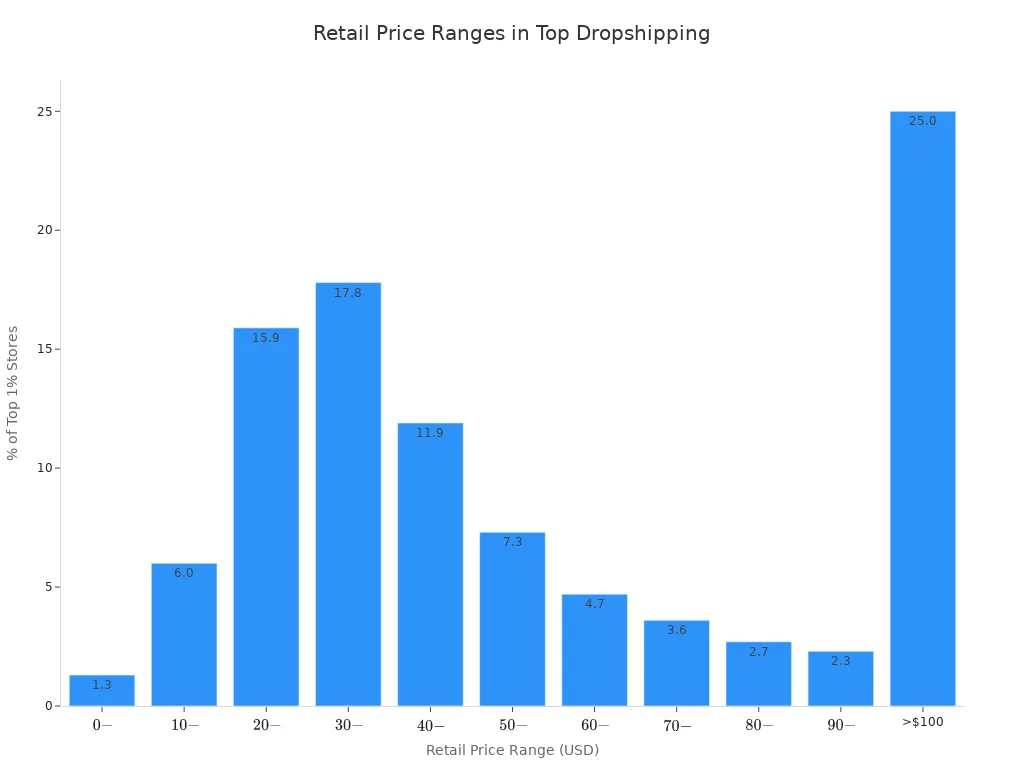
Analyse Competitors
Once you know your costs, it’s time to see what others are charging. Checking your competitors helps you spot the best price range and avoid setting prices that are too high or too low. You don’t want to be the cheapest if it means losing money, but you also don’t want to scare off buyers with high prices.
You can use tools like Shine Commerce (formerly Commerce Inspector) for real-time price tracking and alerts. Other handy options include Dropship, Thieve, Ecomhunt, SalesSource, Importify, and Shopify spy tools like PPSPY and SimplyTrends. These tools let you see what’s selling, how much others charge, and even what ads your rivals run. Free resources like the Facebook Ad Library can also show you what’s trending and how competitors promote their products.
Note: Regularly check your main competitors. If you spot a sudden price drop or a new offer, you can react quickly and keep your shop attractive.
Know Your Customer
Understanding your customer is just as important as knowing your costs and competitors. If you know what your shoppers value and how much they’re willing to pay, you can set prices that feel fair and tempting.
Try using prices that end in ‘9’, like $29.99. This makes products look cheaper and can boost sales.
Offer bundles or package deals. People often pay more for a set than for single items.
Test free-plus-shipping offers. Shoppers love the word “free” and may pay for delivery even if the product costs nothing.
Give clear product details and use interactive images or videos. When customers see exactly what they’re getting, they feel more confident about paying your price.
Use scarcity tactics, such as “Only 3 left!” or “Sale ends soon”. This creates urgency and encourages quick decisions.
Build trust with transparent pricing, secure payment options, and a smooth checkout. When people trust your shop, they’re more likely to pay your asking price.
If you listen to your customers and watch how they react to different prices, you’ll learn what works best. This helps you Price Dropshipping Products in a way that matches both your business goals and your customers’ expectations.
Choose Strategy

Now that you know your costs, your competitors, and your customers, it’s time to pick the best pricing strategy for your shop. This step can make or break your profits. You want a method that fits your products, keeps you legal, and helps you stand out.
Here’s a simple way to choose the right strategy for your dropshipping business:
Think about your product type. Electronics, fashion, and home decor all behave differently. High-ticket items like gadgets often need a different approach than low-cost accessories. Some products sell in high volume but have low margins, while others sell less but bring bigger profits.
Check your supplier’s rules. Some suppliers set a Minimum Advertised Price (MAP). You must follow these rules or risk losing your right to sell their products. Always read the fine print before setting your prices.
Look at your product cost and value. Decide if you want to use a fixed amount or a percentage markup. For example, you might add £10 to every item under £30, but use a 30% markup for items over £50.
Try tiered markups. If you sell products at many price points, use different markups for each range. This helps you keep good margins on cheap items and stay competitive on expensive ones.
Consider the manufacturer’s suggested retail price (MSRP). You can price at MSRP to avoid price wars or offer a small discount to attract buyers.
Use psychological pricing. Prices ending in .99 or .95 look cheaper and can boost sales. Shoppers often see £19.99 as much less than £20.
Add fixed fees if needed. Cover payment processing or platform fees by adding a set amount to low-cost items. This keeps every sale profitable.
Decide how to handle shipping. You can keep product prices low and charge for shipping, or raise your product price and offer free shipping. Many shoppers love free shipping, even if the product costs a bit more.
Feature popular products. Set competitive prices on bestsellers to draw in customers. Once they’re in your shop, they may buy more.
Stay flexible. Markets change fast. Use automation tools to update prices when suppliers change costs or during busy sales seasons.
Tip: You don’t have to stick to just one strategy. Mix and match based on your products and goals. For example, use cost-plus for evergreen items, value-based for unique products, and dynamic pricing for trending gadgets.
Here’s a quick table to help you match strategies to your needs:
Product Type | Best Strategy | Why It Works |
|---|---|---|
High-volume, low-cost | Tiered or cost-plus | Keeps margins steady |
High-ticket, unique | Value-based or MSRP | Maximises perceived value |
Trendy or seasonal | Dynamic or competitive | Reacts quickly to market changes |
MAP-restricted | MSRP or MAP-compliant | Ensures you follow supplier rules |
Choosing the right pricing strategy is not a one-time job. Keep testing and tweaking as you learn what works for your shop. Stay alert for changes in supplier costs, customer trends, and new competitors. The best shops keep their pricing flexible and always look for ways to improve.
Price Calculation

Formulas
Getting your pricing right starts with the right formula. You have a few main options to choose from. Here are the most common ways dropshippers set their prices:
Cost-Plus Pricing
You add a set percentage or amount to your total cost. This covers your expenses and gives you a profit.Selling Price = Cost of Product + (Cost of Product x Markup Percentage)For example, if your product costs £10 and you want a 30% markup, your selling price is £13.
Target Price Formula
You work backwards from your desired profit margin.Selling Price = Cost per Unit / (1 - Desired Profit Margin)If your cost is £20 and you want a 25% margin, your price is £26.67.
Profit Margin Formula
This helps you check if your pricing is healthy.Profit Margin (%) = [(Selling Price - Total Expenses) / Selling Price] x 100
Many dropshippers use the "3x supplier price rule" for low-cost items. You simply multiply your supplier’s price by three. This covers your costs, ads, and leaves room for profit. For higher-priced or unique products, you might use a smaller markup but focus on value.
Note: Always include every cost—shipping, fees, ads, and even taxes. This keeps your profits safe.
Examples

Let’s see how these formulas work in real life. You’ll notice that different products need different approaches.
Low-Cost Gadgets
Imagine you find a phone case for $6.50. Using the 3x rule, you set your price at $19.95. This covers your costs and gives you a healthy margin. Cheap women’s bags often cost $30 wholesale and sell for $49.99, giving you about $15 profit per sale.High-Ticket Items
High-ticket products like luxury handbags or 3D printers need a different approach. For example, a branded handbag might cost €586 and sell for €1,950. That’s a profit of €1,364 per bag! For gadgets like resin 3D printers, you might pay $300 and sell for $1,200, focusing on value and brand.Niche Products
Niche items like perfumes, home theatre systems, or pet tech gadgets often have high perceived value. You can set higher markups, especially if your product solves a problem or feels exclusive. For example, a table lamp costing $110 can sell for $200, giving you an 82% margin.
Here’s a quick table to show you how profit can look for different products:
Product Type | Cost (USD) | Selling Price (USD) | Gross Profit per Unit | Gross Margin (%) |
|---|---|---|---|---|
Phone Case | $6.50 | $19.95 | $13.45 | 67% |
Women’s Bag | $30 | $49.99 | $19.99 | 40% |
Luxury Handbag | €586 | €1,950 | €1,364 | 70%+ |
Table Lamp | $110 | $200 | $90 | 45% |
$86 | $169 | $83 | 96% |
You can see that high-margin products often bring in $20, $40, or even more per sale. These profits add up fast, especially if you pick products with low shipping costs and low return rates.
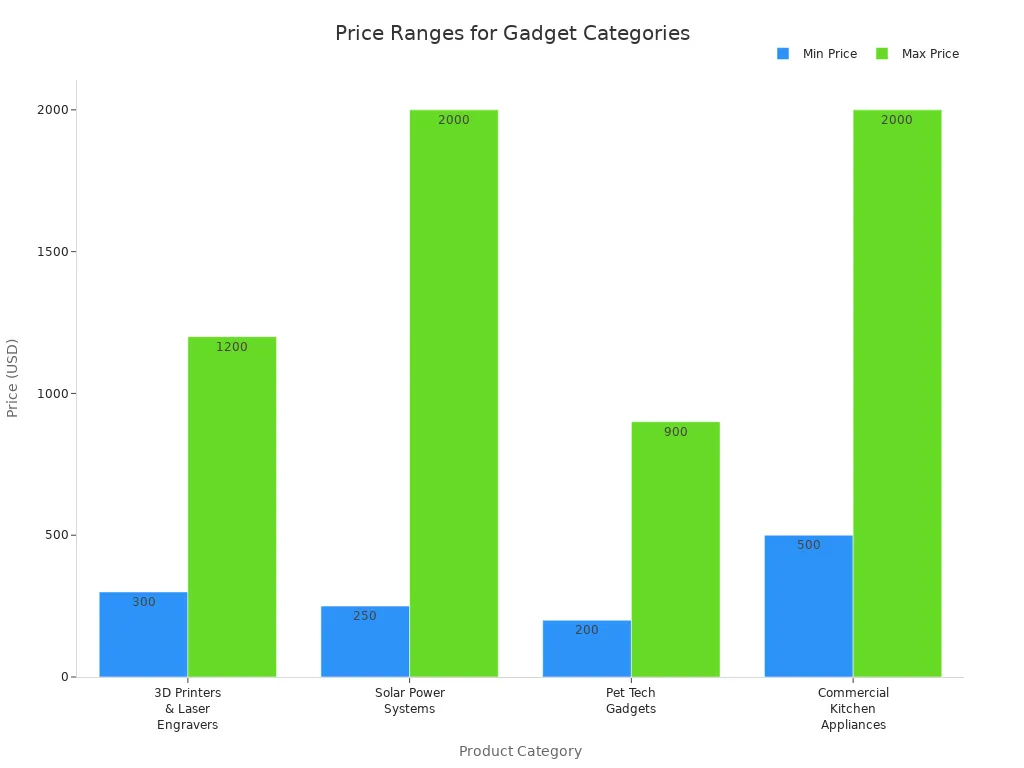
Tip: Always check if your supplier has a Minimum Advertised Price (MAP) policy. If they do, never price below that level. This keeps you safe and protects your right to sell.
Optimise and Maintain Margins
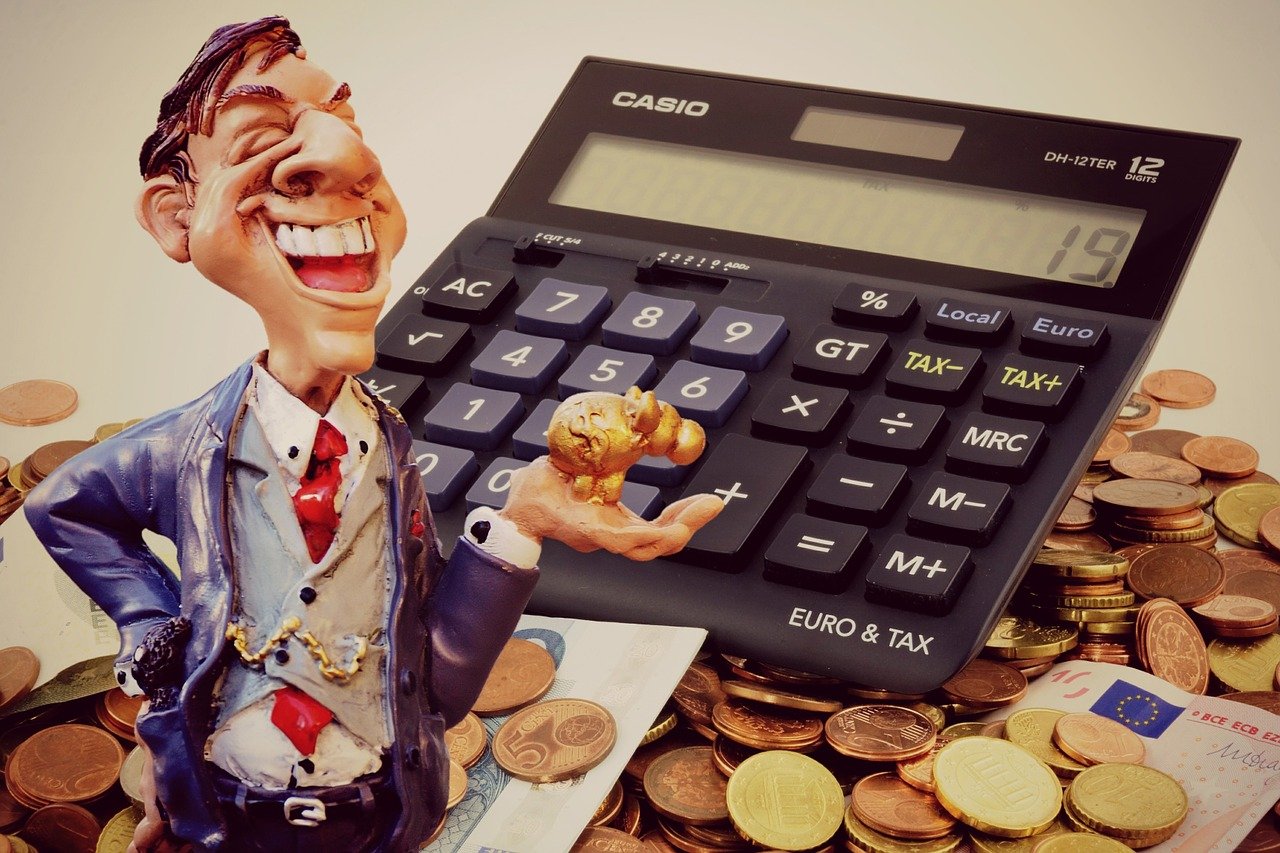
Monitor Prices
Keeping an eye on your prices is key if you want to protect your profits. Prices in dropshipping can change quickly. Suppliers might raise their costs, or competitors might drop their prices overnight. If you do not watch your prices, you could lose money without even noticing.
Here’s a simple way to stay on top of things:
Use software to track your prices and get alerts when something changes. This saves you time and helps you spot problems fast.
Set rules for your prices. Decide the lowest price you will accept (your price floor) and the highest you want to charge (your price ceiling). This keeps your margins safe.
Check your supplier costs often. If your supplier raises prices, update your shop right away.
Look at pricing trends and past sales data. This helps you see what works and plan for busy times.
Adjust your pricing for each marketplace. Different sites have different fees and shoppers.
Link your price monitoring with your inventory system. This makes it easy to update prices and manage stock.
Review your price data and what your competitors charge. Use this to make smart changes.
Tip: Regular price reviews help you spot trends and keep your shop profitable.
Use Tools

You do not have to do everything by hand. Automation tools make your life much easier. They help you change prices quickly, track supplier costs, and avoid mistakes.
Flxpoint is a great tool for this. It tracks supplier prices in real time and updates your shop automatically. You can set your own pricing rules, so you never sell at a loss. If your supplier changes their price, Flxpoint sends you an alert. This means you can react fast and keep your profits safe.
AutoDS is another popular choice. It lets you set rules for your prices and updates them for you. You can scale your shop faster because you do not have to check every product yourself. AutoDS also helps you test different pricing strategies and see what works best.
Note: Automation tools save you hours each week and help you avoid costly errors.
Avoid Price Wars

Price wars can ruin your profits. When you and your competitors keep lowering prices, nobody wins. Margins shrink, and it gets hard to run your business.
You can avoid price wars by focusing on what makes your shop special. Offer unique products or bundles that others do not have. Use automation tools like SuperDS to manage your listings and keep your prices competitive without always being the cheapest.
Pick reliable suppliers and choose products with steady demand.
Use repricing tools that let you set rules, so you never go below your minimum margin.
Build a strong brand and offer great service. Shoppers will pay more if they trust you.
Watch your competitors, but do not copy every price drop. Sometimes it is better to wait until they run out of stock.
Remember: Competing on value, not just price, keeps your business healthy and your margins strong.
Cross-Sell

Cross-selling is one of the smartest ways to boost your profits in dropshipping. You do not just sell one product—you help your customers discover more things they want. When you do this well, your average order value (AOV) goes up, and so does your margin.
You can start by looking at your product catalogue. Find items that go well together. For example, if someone buys a phone case, suggest a screen protector or a charging cable. These are natural pairs. You can use apps that show these suggestions right on the product page or in the shopping cart. Some tools even use AI to recommend items based on what your customer has looked at or bought before.
Here are some simple ways to cross-sell in your shop:
Set a free shipping threshold just above your current average order value. If your AOV is £25, offer free shipping for orders over £35. Shoppers will often add another item to get the deal.
Remind customers about the free shipping offer at checkout. A small pop-up or banner can do the trick.
Create product bundles. Offer deals like “Buy three, get one free” or “Save 15% when you buy these together.” Make sure the bundle makes sense and gives real value.
Use pop-ups or cart suggestions to show complementary products. For example, “People who bought this also liked…” or “Complete your set with…”
Offer small gifts or loyalty points when customers add extra items. Even a simple thank-you note or a discount on their next order can encourage bigger baskets.
Personalise your offers. Segment your customers by what they like or have bought before. Send them emails with bundle deals or new product suggestions that match their interests.
Use retargeting ads to remind visitors about products they viewed but did not buy. You can also show them bundles or related items in these ads.
Tip: Always make sure your bundles and cross-sell offers are profitable. Check your costs and set prices that keep your margins healthy.
You can also use upselling. Suggest a higher-end version of the product your customer is looking at. Show the benefits clearly, so they see why it is worth the extra money.
Here is a quick table to help you plan your cross-sell strategy:
Cross-Sell Tactic | How It Helps You Profit |
|---|---|
Free shipping threshold | Increases order size |
Product bundles | Raises AOV and clears inventory |
Personalised suggestions | Boosts conversion and loyalty |
Upselling | Increases profit per sale |
Adds last-minute purchases |
When you use cross-selling and upselling together, you make every sale count. Your customers get more value, and your business grows stronger. Try different tactics, track your results, and keep improving your offers. Over time, you will see your average order value and profit margins rise.
Tips for 2025

Test and Adapt
You cannot set your prices once and forget about them. The dropshipping world moves fast, so you need to keep testing and adapting. Try different prices, bundles, and offers to see what works best for your shop. Use real-time profit tracking tools like TrueProfit to watch your margins closely. These tools help you spot when costs change, such as new tariffs or supplier fees. You can then adjust your prices quickly.
Here are some smart ways to test and adapt your pricing in 2025:
Track your profits in real time to see how each change affects your bottom line.
Raise prices slowly and explain any added value to your customers. This keeps their trust.
Look for suppliers in countries with lower tariffs. This gives you more room to adjust prices.
Bundle products together to increase the average order value and make price changes feel like a better deal.
Use AI and automation tools to make data-driven pricing decisions. These tools help you react fast to market changes.
Test different checkout options and upsells to see what boosts your sales.
Do regular market research and talk to your customers. This helps you personalise your pricing and marketing.
Reinvest your early profits into ads and more testing. This helps you find the best prices for your products.
Keep notes on every test you run. Learn from your wins and mistakes.
Pick trending products with good margins and low competition. This gives you more power to set your prices.
Tip: Testing is not a one-time job. Make it part of your weekly routine to stay ahead.
Follow Trends

You need to keep an eye on what is hot in the market. Use tools like Google Trends to spot seasonal spikes, new product categories, and popular regions. When you see a trend, you can adjust your prices to catch more sales during busy times. AI-driven tools and data analytics help you track what people want right now. They look at social media, search engines, and other online platforms to predict demand.
If you sell eco-friendly products, you have an extra advantage. More than half of shoppers are happy to pay more for sustainable items. You can set higher prices for these products and still attract buyers. By following trends and using data, you make smarter pricing choices and stay ahead of your competitors.
Customer Feedback

Your customers can tell you a lot about your prices. Listen to them and use their feedback to improve your shop. There are many ways to collect and use this information:
Send out online surveys and feedback forms.
Chat with customers on social media to learn what they like.
Run one-on-one interviews or focus groups for deeper insights.
Check your sales data and read customer reviews to spot patterns.
Watch what your competitors charge and how their customers react.
Offer personalised discounts based on what your customers have bought before.
Use price optimisation software to test different prices and see what works best.
You can also use tools like Zigpoll to get real-time feedback on price sensitivity and product preferences. Try A/B testing to compare different price points and offers. If you notice people leaving their carts, use exit-intent surveys to find out why. Adjust your prices and offers based on what you learn. This way, you keep your customers happy and your profits strong.
Summary and Action

Key Points
You have learned a lot about pricing dropshipping products for 2025. Let’s go over the most important ideas so you can boost both your sales and your profit margins:
Focus on profit margins, not just sales numbers. Even a small price increase can raise your overall profit, even if you sell a few less items.
Use value-added promotions like “buy one, get one half off” or tiered discounts. These offers keep your products attractive without hurting your margins.
Create urgency with phrases like “Limited Stock” or “Flash Sale”. This encourages shoppers to buy now instead of waiting.
Benchmark your prices with tools such as Google Shopping, PriceSpy, or Sell The Trend. These help you see what works for top sellers and spot pricing trends.
Try psychological pricing tricks. Charm pricing (like £9.99 instead of £10) and prestige pricing for luxury items can make your products look more appealing.
Test your prices often. Small changes can help you find the sweet spot where customers are happy and your profits stay strong.
Pick the right pricing strategy for each product. You might use cost-plus, tiered markups, or value-based pricing depending on what you sell.
Bundle products and offer free shipping to increase the average order value. Cross-selling related items also helps you earn more from each customer.
Aim for profit margins above 20%. Some sellers reach 100% or even 300% margins with the right products and suppliers.
Balance competitive pricing with healthy profits. Don’t let rivals force you into a race to the bottom.
Remember: Understand your customers. High-end buyers may pay more, while bargain hunters want deals. Use this knowledge to set prices that work for your audience.
Next Steps
Now it’s time to put these ideas into action. Here’s what you can do right away to improve your pricing and grow your dropshipping business in 2025:
Review your product list. Sort items into fast, steady, and slow movers. Discount slow sellers to free up cash and make room for new stock.
Cut your shipping costs. Use several carriers, negotiate better rates, and try shipping software to find the cheapest option for each order.
Talk to your suppliers. Ask for discounts on bulk orders or better payment terms. This lowers your costs and gives you more room to adjust prices.
Start with small price changes. Use dynamic pricing tools, but set clear price limits so you don’t confuse customers.
Use psychological pricing. Try charm pricing, show original prices next to discounts, and bundle products to encourage bigger orders.
Make sure your pricing matches your brand. If you sell luxury goods, keep prices high to show quality. For everyday items, stay competitive but protect your margins.
Track your results. Watch how each change affects your sales and profits. Adjust your strategy based on what works best.
Tip: Keep testing and learning. The market changes quickly, but if you stay flexible and focus on value, you’ll keep your business strong in 2025.
You now know how to price dropshipping products for better sales and margins. Use data to guide your choices. Stay flexible and ready to adjust your prices. Review your pricing often to keep up with the market.
Remember: The best results come when you test, learn, and act on what works. Start using these strategies today and set yourself up for dropshipping success in 2025! 🚀

FAQ
How often should you update your dropshipping prices?
You should check your prices every week. If your supplier changes costs or you spot a new trend, update your prices right away. Staying alert helps you keep your profits safe.
What is the best profit margin for dropshipping in 2025?
Aim for at least 20% to 30% profit margin. If you sell unique or high-value products, you can go higher. Always cover all your costs before setting your final price.
Can you use more than one pricing strategy?
Yes, you can mix strategies. Try cost-plus for everyday items and value-based pricing for special products. This approach helps you stay flexible and boost your profits.
How do you avoid a price war with competitors?
Focus on value, not just price. Offer bundles, better service, or unique products. Use automation tools to set price limits. Never drop your prices below your minimum margin.
What tools help with dropshipping price management?
You can use tools like AutoDS, Flxpoint, and Shine Commerce. These tools track costs, update prices, and watch your competitors. They save you time and help you avoid mistakes.
Should you include shipping costs in your product price?
You can add shipping to the product price and offer “free shipping.” Many shoppers like this. Or, show shipping as a separate cost. Test both to see what your customers prefer.
What if your supplier has a Minimum Advertised Price (MAP) policy?
Always follow MAP rules. Never price below the minimum set by your supplier. Breaking MAP can get you banned from selling those products.
How do you know if your prices are too high or too low?
Watch your sales and customer feedback. If sales drop, your price may be too high. If you sell out fast, you might be too cheap. Test different prices to find the sweet spot.


TangBuy: A Smarter Way to Dropship in 2025
If you're looking to stay competitive with dropshipping in 2025, speed and trend-awareness are key. TangBuy helps you stay ahead with real-time product trends, fast fulfilment, and factory-direct sourcing. With over 1 million ready-to-ship items, 24-hour order processing, and seamless Shopify integration, TangBuy makes it easier to test, scale, and succeed in today's fast-moving eCommerce landscape.
See Also
Top Dropshipping Concepts To Earn Profits In 2025
Understanding The Real Expenses Of Dropshipping In 2025
High Earning Dropshipping Markets To Target In 2025
